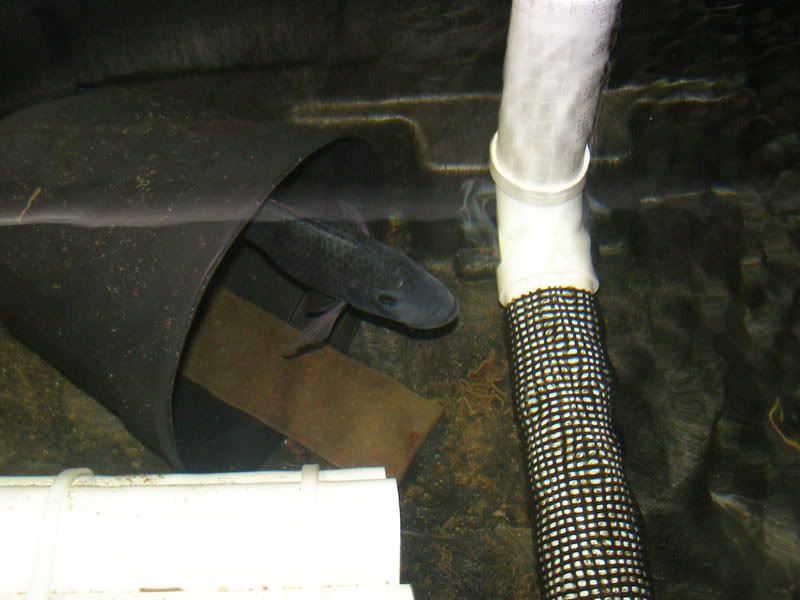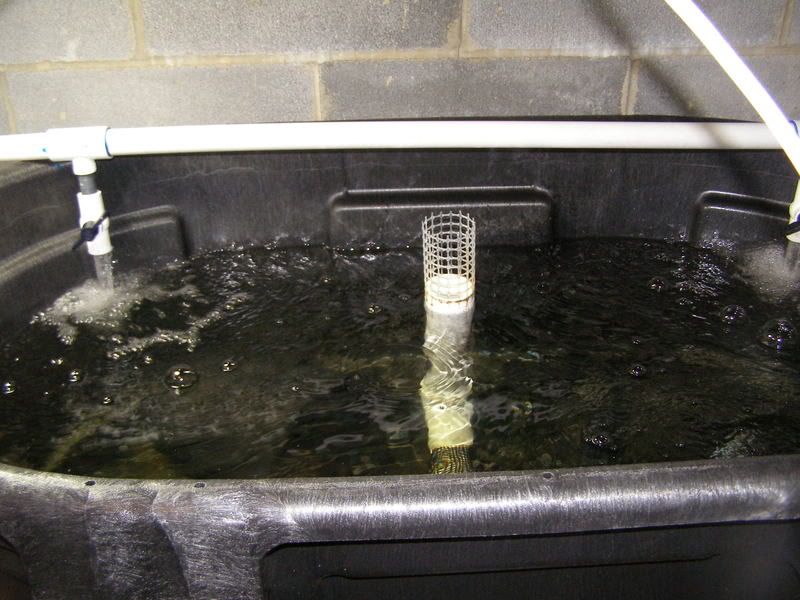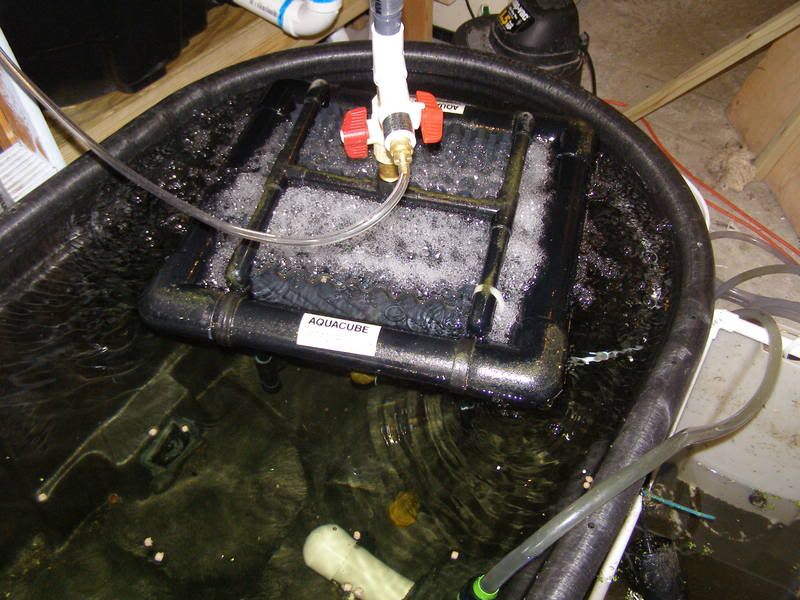My main recirculating system is currently in my basement. I'll be hopefully moving it to my greenhouse once I get it built. The primary function is to breed tilapia and sell fry.
When it was first built I used Rubbermaid 100 gallon stock tanks. I am now in the process of converting some over to glass. The current system has 4 stock tanks and 3 glass tanks.
Here is a shot of the outside of my double decker tanks. I built wooden shelves to hold one tank above the other to optimize space:
It is plumbed with 2" PVC pipe. I removed the drain fittings, enlarged the hole and replaced it with 2" bulkhead fittings. The loop you see on the outside maintains a constant water level in the tank.
This is a shot of the inside:
In the 1st picture you see the pipe that fits into the bulkhead fitting. I drilled 1" holes along the bottom of the pipe and covered it with screened tubing. This allows the system to take a suction off the bottom and pick up the fish solids. The second picture shows my fail-safe and also the water supply. The fail-safe takes the pipe and continues it to the surface just above the normal water level. I put some screened tubing over that to keep the fish out. If the bottom plugs for some reason, the water level would rise and go out the overflow.
The inlet piping is one inch. It starts off as 1.5" at the filter and drops in size as the water is distributed. The idea is to maintain a constant water velocity and smaller pipe and valves are also cheaper. The valves allow me to regulate flow to each tank.
Piping returns the water to a central sump. In the sump is my primary biological filter as there are no plants in this system. I use a clever device called an aquacube:
4 large 8" air stones sit underneath and provide bubbles to move the water through a series of baffles. The baffles support the bacteria that do the bio filtration. The water is saturated with oxygen, so they do an awesome job. It can't clog and never needs cleaning. It also moves about 50 gallons per minute through the filter allowing bio filtration for thousands of tilapia in a larger pool type system. I use a small regenerative blower to provide the system with the air it needs. Each tank has a separate 6" airstone and the blower and pump are off separate circuits in case one blows.
I use a small 1/2 horse pool pump and standard Hayward sand filter to remove the particulates. This requires a back-wash about every 3rd day. The sand has been replaced with plastic permabeads which don't break down like sand. They also proved a fair amount of bio filtration once they are in use for a while. The back-wash gets settled out and de-watered and the solids go into my worm bin. Once I get the grow-beds up in the greenhouse, the back-wash will go to the beds.
The system is heated with 2 1KW bucket heaters I found at a farm supply place. I have them hooked up to a digital Honeywell thermostat. The heaters are only about $25 each, and the thermostat was $60, so for $110 I have enough heat for them. As you might imagine, the electric bill went up. I also have a back-up generator, just in case the lights go out.
I've replaced two of the tanks with glass ones since I set the system up. It is far easier to tell if the females are holding fry. For grow-out tanks, the tubs are fine.
Results 1 to 10 of 42
Thread: My 700 gallon basement system
-
02-22-2009, 03:35 PM #1
My 700 gallon basement system
The best fertilizer is the farmer's shadow
-
02-22-2009, 07:27 PM #2
Re: My 700 gallon basement system
Nice! hope in a couple of years I will have graduated to that point
 I use the Linux Operating System ...... Free as in beer!
I use the Linux Operating System ...... Free as in beer!
You're never too old to learn something
Aquaponics - food'n'fish at your doorstep
Helena, Montana - Home of the Northernmost Monument to the Confederacy
-
02-23-2009, 11:29 AM #3
Re: My 700 gallon basement system
This is the bucket heater I use:
http://www.jeffersequine.com/ssc/produc ... f_id=16047The best fertilizer is the farmer's shadow
-
02-23-2009, 06:32 PM #4Members

- Join Date
- Feb 2008
- Location
- Smithville,Ohio
- Posts
- 73
Re: My 700 gallon basement system
BadFlash,
I'm very impressed with your system!
IronFish
-
02-23-2009, 06:45 PM #5
Re: My 700 gallon basement system
Ironfish,
 Welcome back. A lot has been happening in you absense. You have been sorely missed
Welcome back. A lot has been happening in you absense. You have been sorely missed  JCO
JCO
Irish eyes are always smiling but- "In the eyes of the world, you are only as good as your last success"
- "MAN IS ONLY LIMITED BY HIS IMAGINATION"
-
02-23-2009, 10:07 PM #6
Re: My 700 gallon basement system
Isn't 100 degrees a little warm? Or does it cool enuff when it's circulating? Or is that just a sales point, and the thermostat is a controllable, so you can turn it down to 75 to 80? Originally Posted by badflash
Originally Posted by badflash
 Originally Posted by jeffersequine.com
I use the Linux Operating System ...... Free as in beer!
Originally Posted by jeffersequine.com
I use the Linux Operating System ...... Free as in beer!
You're never too old to learn something
Aquaponics - food'n'fish at your doorstep
Helena, Montana - Home of the Northernmost Monument to the Confederacy
-
02-24-2009, 06:45 AM #7
Re: My 700 gallon basement system
The 100 is a fail safe cut-off. I have it plugged into a separate temperature controller. Tilapia can live at 100, but they don't like it.
The best fertilizer is the farmer's shadow
-
03-01-2009, 04:32 AM #8
Re: My 700 gallon basement system
What is aquacube..it needs allot of air I am guessing...it runs 27/7 too?
""we are what we eat""
-
03-01-2009, 08:42 AM #9
Re: My 700 gallon basement system
The Aquacube is my primary filter as well as my primary aerator. Yes, it takes lots of air, but any system my size or bigger needs it. I use a 1/4 HP regenerative blower 24/7. These are very reliable devices and run 20+ years without doing anything to them except cleaning the intake filter.
Check http://www.advancedaquaculture.com/aqua ... _sheet.htm
Never needs cleaning, can't clog. water exiting is fully oxygenated. In a large swimming pool these are idea. Just using bubbles over 50 GPM moves through the filter. You need something like that to handle the needs of 10,000 tilapia.The best fertilizer is the farmer's shadow
-
03-02-2009, 02:52 PM #10
Re: My 700 gallon basement system
Very interesting, I worked on turbojet engines years ago and these remind me of the way they operated by compressing (we called them compressor stages) air then expelling it out. No plants needed on your systems is what caught my eye..I just had to understand how you can do that.
I saw this on a web site:
As the impeller rotates, air is captured between each blade on the impeller and is pushed both outward and forward into the channels. The air then returns to the base of the blade. This process is repeated over and over as the impeller spins. It is this regeneration that gives the blower its pressure / vacuum capabilities. In essence, a regenerative blower operates like a staged reciprocal compressor and while each blade to blade regeneration "stage" results in only slight pressure increases, the sum total, from air entry to outlet can yield, in some makes continuous operating pressures up to 9 psig or vacuum to 14" hg with flows in the 200 to 250 scfm range at these points.
source here http://www.pneumaticsonline.com/Arti...enblowers.html""we are what we eat""
Similar Threads
-
My new basement system!
By Prometheus7504 in forum Back Yard SystemsReplies: 3Last Post: 12-17-2014, 04:08 PM -
Backyard 600 gallon IBC system
By dsrtlzrd32 in forum Back Yard SystemsReplies: 11Last Post: 03-22-2013, 11:55 AM -
Keith's basement winter system
By keith_r in forum Back Yard SystemsReplies: 62Last Post: 10-01-2012, 07:02 AM -
Basement System Design
By Bioritize in forum Want To Know HOW TO..?Replies: 33Last Post: 03-22-2012, 03:03 AM -
100 gallon hobby system
By tayl0r in forum Back Yard SystemsReplies: 4Last Post: 08-14-2009, 04:13 AM








 Reply With Quote
Reply With Quote



